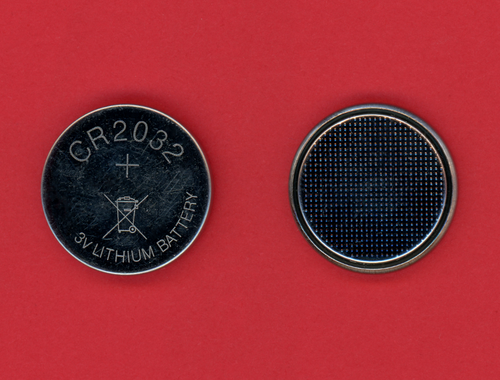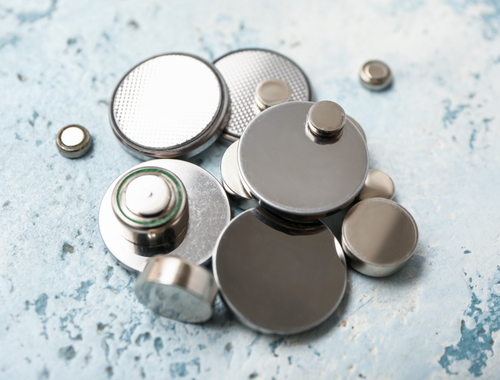Difference Between CR2032 and CR2016
Modern microbatteries come in many forms, from coin and button cells to pouch cells. It was the increasing need for smaller form of batteries with high energy and power density that has given rise to these tiny button cells called microbatteries. The name suggests they are so small that they are directly integrated into electronic circuits. Compared to standard batteries, microbatteries typically have lower energy storage capacity but their compact size make them well suited for use in portable electronic devices and wearable technology such as smart watches. The CR2032 and CR2016 batteries are identical in several ways; in fact, it’s quite difficult to tell the one apart from the other by simply looking at them.

CR2032
The CR2032 is a type of non-rechargeable lithium manganese dioxide battery that is commonly used in portable electronics devices such as smart watches, remote controls, motherboards, and wearable technology. It is a tiny flat cylindrical coin-shaped battery that is commonly used to power small electronic and medical devices. It is a lithium battery with a diameter of 20mm and a height of 3.2mm, making it one of the smallest and thinnest microbatteries available. The CR2032 batteries have a nominal voltage of 3 volts and a capacity of approximately 225 mAh, which is enough to power small devices for a few months, depending on usage of course. The number 20 in CR2032 refers to the diameter and the last two digits suggest the thickness.

CR2016
The CR2016 is yet another common type of lithium coin cell in the 20mm specification. It is also a non-rechargeable, lithium manganese coin battery with the same diameter as the CR2032 battery which the first two digits suggest. It is a flat cylindrical shaped battery with a diameter of 20mm and a thickness of 1.6mm, which makes it smaller and thinner than the CR2032 cells. Like the CR2032 battery, CR2016 also has a nominal voltage of 3 volts, but with a voltage capacity of approximately 90 mAh, which is lower than the CR2032 battery. Its small size and low profile make it well suited for use in small electronic devices such as fitness devices, calculators, and so on. These are very thin, so they slide into battery ports easily.
Difference between CR2032 and CR2016
Thickness
– Both CR2032 and CR2016 are non-rechargeable lithium manganese coin-shaped microbatteries with the same 20mm diameter, which the first two digits so clearly suggest. The last two digits indicate the thickness of the battery. That being said, the CR2032 battery has a thickness of 3.2mm whereas the CR2016 battery has a thickness of 1.6mm, which makes it even smaller and thinner than the former. So, the CR2032 battery is thicker than the CR2016 battery.
Capacity
– Battery capacity is the measure of how much energy a battery can store and provide to a device before it has to be recharged or replaced, and it is measured in amp hours (Ah) or milliamp hours (mAh). The CR2032 has a higher battery capacity of approximately 225 mAh compared to the CR2016, which has a mere capacity of approximately 90 mAh. So, the CR2032 provides more energy storage and more storage means longer runtime for devices.
Durability
– A higher capacity battery means the battery can store more energy and provide a longer runtime for devices, while a lower capacity battery needs to be recharged or replaced more frequently. The CR2032 battery is rated approximately 225 mAh whereas the CR2016 battery is rated approximately 90 mAh. Hence, the numbers suggest the CR2032 batteries can store more energy than the CR2016. The choice between the two depends on the power needs and choice constraints of the devices for which the battery is being used.
CR2032 vs. CR2016: Comparison Chart

Summary
So, in a nutshell, both CR2032 and CR2016 are the same 20mm thickness coin shaped batteries and are well suited for small electronic devices. The CR2032 has a thickness of 3.2mm, while the CR2016 battery has a height of 1.6mm. The CR2032 has a higher energy capacity of approximately 225 mAh compared to CR2016, which has a energy capacity of 90 mAh. So, the CR2032 is thicker and provides more energy storage than the CR2016, meaning the former can provide a longer runtime of devices.
Can I use CR2032 instead of CR2016 in key fob?
Both are coin cell batteries with the same diameter, so the CR2032 battery can be used as a replacement for a CR2016 battery in a key fob, at least in most cases. However, because of its higher energy capacity, the CR2032 will provide a longer battery life for the key fob.
What battery can replace a CR2016?
A CR2025 battery can be used as a replacement for a CR2016 battery is some cases because both have the same diameter of 20mm and almost similar voltage output.
Can I replace a CR2016 battery with a CR2025?
Because both have the same 20mm diameter, the CR2016 can be replaced with a CR2025 battery, but it is recommended to check the device’s specifications to make sure the CR2025 battery is compatible.
What battery can replace CR2032?
In some cases, the CR2025 can be replaced with a CR2032 battery but the former will have a lower capacity of approximately 150 mAh and may not last as long as the CR2032 (225 mAh). But, you need to check the device’s specifications to check if it’s compatible both in terms of physical and electrical specifications.
How long does CR2016 last?
Depending on usage, the temperature and the quality of the battery, the battery can last from several weeks to months. However, some devices are more power hungry, so it can affect the lifespan of the battery and its runtime.
- Difference Between Caucus and Primary - June 18, 2024
- Difference Between PPO and POS - May 30, 2024
- Difference Between RFID and NFC - May 28, 2024
Search DifferenceBetween.net :
Leave a Response
References :
[0]Scott, Mueller. Upgrading and Repairing PCs. Noida, India: Pearson Education India, 2010. Print
[1]Srinivasan, V. Battery Modeling at Cell Level. Pennsylvania, United States: The Electrochemical Society, 2009. Print
[2]O’Shea, Audrey. A Geek Girl's Guide to Electronics and the Internet of Things. New Jersey, United States: John Wiley & Sons, 2020. Print
